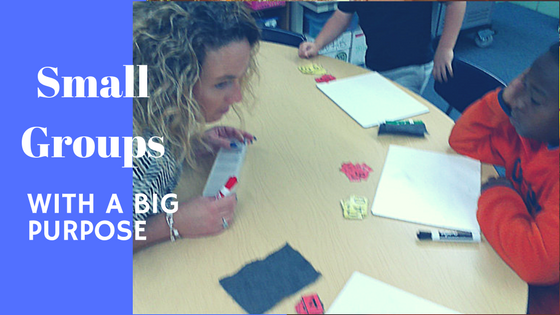
Guided Math Part 4: Small Groups with a Big Purpose
One component about guided math that everyone can agree on, the use of small group instruction. We all know the benefits of working with students in small groups, especially when our class sizes seem to keep growing and the needs of our students continue to deepen. When we think about small groups, we must keep in mind there are different types of small groups, and each serves a unique purpose within your classroom. In this post I am going to focus on need-based groups and content-based groups. They are two very different types of small groups, and we need to find time for both during our instruction.
I like to identify the first type of small group as a "needs-based" group. The purpose of this group is to provide intervention to your students who have gaps in instruction, or on the flip side, need to be enriched. During this type of small group, you are meeting with students either 1:1 or 2:1. The idea is to work with students who have a "like need". The instruction during this time needs to be thought out in advance and you need a very purposeful activity that teaches the concept in a different way. A common mistake with our most-struggling students is we give them the most paperwork to do. Students who require remediation need interventions that provide instruction differently than how it was already presented. We can't just say it louder, or say it slower, or give them more practice problems. Use concrete materials, a different strategy, or ask a child to solve a problem with manipulatives side-by-side with the abstract. Many times games make great interventions.
I am currently working with a struggling 4th grader on combinations to 10. During our time together we work on finding different combinations for a specified number, for example 7. I have her move beads on a number bracelet and draw pictorially different ways to represent 7. I have her match different amounts of counters to make 7. I then transfer the knowledge she is acquiring of making 7 ones, to making 7 tens. Now those beads have a value of 10 instead of a value of 1. She is making the connection that the same combinations we discovered to make 7 ones are the same combinations she needs to make 7 tens or 70. We then transferred this knowledge to 7 hundreds, and 7 thousands. We finish our time together playing a game. An easy game is to take a deck of cards and remove any number higher than the number you are targeting. I took out every card with a value more than 7. As I turned over the top card, she had to tell me how many more to make 7. The activities I suggested here are simple, but they serve a purpose. The repeated exposure of different ways to identify 7 through multiple materials, provided for a stronger intervention than just doing a bunch of practice problems on a piece of paper.
The second type of small group I like to describe is a content-based group. The idea here is to reach the students who need your support on the current content you are teaching. These groups should be fluid and are formed from your formative assessment. In the last post I discussed the role of whole-group instruction and the need to be doing formative assessment throughout the lesson. The students who are struggling with the content need to meet with you during independent practice. Because these students all have a like-need in the content you are covering, this may be a larger group than I previously described. Sometimes you may have up to 7 students with you. The idea is you aren't leaving them alone to struggle through an independent practice assignment. They may need a little more time to grasp the concept or a little support from you when asked to apply what they learned.
Another way teachers use content-based groups, is if they teach a mini-lesson to the whole class. The mini-lesson would be around 10-15 minutes. Students would then rotate through different stations, one of which would be a teacher station. During this "math with the teacher time", the teacher would continue the instruction from the mini-lesson with each group of students. The focus of these groups continues to be on the current content, not remediation. This does allow the teacher to meet with all students in a small group every day, or several times a week depending upon which rotation system is in place. (We will cover this in the next post.) These groups can be formed with like-ability students or mixed-ability students. My word of caution with like-ability students: often your lower-level students don't get exposed to multiple ways of thinking. We know students learn best from their peers. We must encourage this throughout our math instruction. If we only group students with like-minded peers, they often miss out on hearing different ways of thinking.
In the teacher resources tab, I provided you with some planning forms you may wish to use. Keep it simple! Don't try to overcomplicate what you are recording, but be sure to have enough information to share with parents and team members.